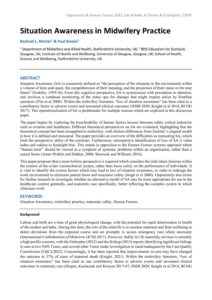| Document | Author Rachael L. Martin & Paul Bowie |
| Abstract Situation Awareness (SA) is commonly defined as “the perception of the elements in the environment within a volume of time and space, the comprehension of their meaning, and the projection of their status in the near future” (Endsley, 1995:36). From this cognitive perspective, SA is synonymous with perception or attention, and involves a continual monitoring of the status quo for changes that might require action by frontline operators (Flin et al 2008). Within the midwifery literature, “loss of situation awareness” has been cited as a contributory factor to adverse events and unwanted clinical outcomes (HSIB 2020; Knight et al 2014; RCOG 2017). This operationalisation of SA is problematic for multiple reasons which are explored in this discussion paper. The paper begins by exploring the transferability of human factors lessons between safety critical industries such as aviation and healthcare. Different theoretical perspectives on SA are evaluated, highlighting that the theoretical concept has been misapplied in midwifery, with distinct differences from Endsley’s original model in how it is defined and measured. The paper provides an overview of the difficulties in measuring SA, which limit the prospective utility of the construct. Furthermore, retrospective identification of loss of SA is value laden and subject to hindsight bias. This stands in opposition to the Human Factors systems approach where “human error” should be viewed as a symptom of systemic problems within an organisation, rather than a causal factor (Amer-Wahlin and Dekker, 2008; Shorrock and Williams 2016). This paper proposes that a more holistic perspective is required which considers the individual clinician within the context of the wider sociotechnical system, rather than focus solely on the performance of individuals. It is vital to identify the system factors which may lead to loss of situation awareness, in order to redesign the work environment to minimise patient harm and maximise safety (Singh et al 2006). Opportunity also exists for further research to investigate whether an alternative model of SA may be more appropriate for use in the healthcare context generally, and maternity care specifically, better reflecting the complex system in which clinicians work. |

